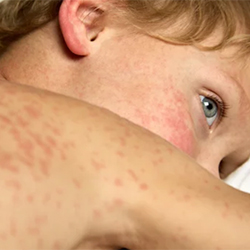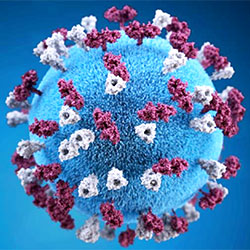By IDSE News Staff
The Texas Department of State Health Services (DSHS) said this year’s measles outbreak centered in West Texas has ended because it has been more than 42 days since a new case was reported. Other states are still reporting cases, but overall the national outbreaks appear to be slowing down.
Public health professionals consider the end of a measles outbreak after 42 days with no new cases because that is double the disease’s maximum incubation period.

As of Aug. 18, 762 cases of measles—the most in any state—have been confirmed in the outbreak since late January. More than two-thirds of the cases occurred in children. Ninety-nine Texans were hospitalized over the course of the outbreak, and there were two fatalities in school-age children.
“I want to highlight the tireless work of the public health professionals across the state who contributed to the containment of one of the most contagious viruses. We arrived at this point through a comprehensive outbreak response that included testing, vaccination, disease monitoring and educating the public about measles through awareness campaigns,” said DSHS Commissioner Jennifer A. Shuford, MD, MPH. “I also want to recognize the many health care professionals who identified and treated cases of a virus that most providers had never seen in person before this outbreak.”
However, the end of this outbreak does not mean the threat of measles is over, state health officials warned in a statement. Since there are ongoing outbreaks of measles in North America and globally, it is likely more cases will be seen in Texas this year. Healthcare providers should continue to be vigilant and test for measles if their patient has symptoms compatible with the virus.
Measles is a highly contagious respiratory illness, which can cause life-threatening illness to anyone who is not protected against the virus. During a measles outbreak, about 1 in 5 children who get sick will need hospital care and 1 in 20 will develop pneumonia, the health department said.
Although he commended the work of the Texas DSHS in stopping the outbreak, Sen. Bill Cassidy, MD (R-La.), called on parents and caregivers to make sure that children are vaccinated against this highly contagious disease.
“This tragedy was entirely preventable, and work must continue to curb outbreaks in other states. Misinformation about the measles vaccine fueled the spread of this outbreak, killing three Americans and hospitalizing many more. No child in the United States should ever die of a vaccine-preventable disease,” he said in a statement. “The measles vaccine is effective, safe, and the best way to protect yourself and your family from contracting this deadly disease. I encourage every parent to vaccinate their child to prevent needless death in the future.”
Although the outbreak has ended in Texas, the surrounding states are still seeing cases. New Mexico reported 100 measles cases, mostly among unvaccinated people, as of Aug. 14. Since the outbreak began in February, the New Mexico Department of Health (NMDOH) has been aggressively vaccinating people in the state. Between Feb. 1 and Aug. 13, 48,620 people have received the measles, mumps, and rubella vaccine. One dose of MMR vaccine is 93% effective and two doses are 97% effective, providing lifetime protection.
“We remain grateful New Mexicans continue to get their measles vaccination in an effort to slow the spread of the virus,” said Miranda Durham, MD, the NMDOH chief medical officer. “Without that, measles outbreaks are more likely to last longer and grow over time.”
Oklahoma has reported 20 cases so far, mostly among unvaccinated people. Both Arkansas and Louisiana have reported fewer than 10 cases. All three are conducting vaccination campaigns.
It appears that cases are winding down throughout the country, but the outbreaks are not over, according to the CDC. As of Aug. 13, the CDC said there were 1,356 confirmed measles cases in 41 jurisdictions. Thirty-two separate outbreaks have been reported in 2025. Most of the cases were among children, with 28% (386) occurring in those younger than 5 years of age and 37% (501) in those 5 to 19. Most of those infected (92%) were unvaccinated or their vaccination status was unknown; 4% only received one dose of a measles-containing vaccine.
The CDC reported that 13% of cases had been vaccinated and most of those hospitalized were children: 82 (21%) were children younger than 5 and 8% (40) were between 5 and 19 years old. There were three confirmed deaths; two were among children.




